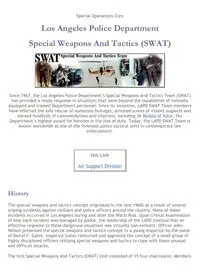Table Of ContentSpecial Operations.Com
Los Angeles Police Department
Special Weapons And Tactics (SWAT)
Since 1967, the Los Angeles Police Department’s Special Weapons And Tactics Team (SWAT)
has provided a ready response to situations that were beyond the capabilities of normally
equipped and trained Department personnel. Since its inception, LAPD SWAT Team members
have effected the safe rescue of numerous hostages, arrested scores of violent suspects and
earned hundreds of commendations and citations, including 36 Medals of Valor, the
Department’s highest award for heroism in the line of duty. Today, the LAPD SWAT Team is
known worldwide as one of the foremost police tactical units in contemporary law
enforcement.
History
The special weapons and tactics concept originated in the late 1960s as a result of several
sniping incidents against civilians and police officers around the country. Many of these
incidents occurred in Los Angeles during and after the Watts Riot. Upon critical examination
of how each incident was managed by police, the leadership of the LAPD realized that an
effective response to these dangerous situations was virtually non-existent. Officer John
Nelson presented the special weapons and tactics concept to a young inspector by the name
of Darryl F. Gates. Inspector Gates concurred and approved the concept of a small group of
highly disciplined officers utilizing special weapons and tactics to cope with these unusual
and difficult attacks.
The first Special Weapons And Tactics (SWAT) Unit consisted of 15 four-man teams. Members
Hot Link
Air Support Division
of each team, who volunteered from the ranks of patrol and other police assignments, had
specialized experience and prior military service. Each unit was activated for monthly
training or when the need for special weapons personnel actually arose. These units, known
as "station defense teams," provided security for police facilities during civil unrest.
In 1971, the SWAT personnel were assigned on a full-time basis to Metropolitan Division to
respond to continuing action by subversive groups, the rising crime rate and the continuing
difficulty of mustering a team response in a timely manner. Metropolitan Division, which had
a long-established reputation as the tactical unit of the Department, was organized into "A",
"B" and "C" Platoons. The Special Weapons And Tactics Unit was given the designation of "D"
Platoon, and at the same time formally adopted the acronym SWAT.
Challenges Faced by SWAT
The first challenge to these pioneers in the field of special weapons and tactics came in
1969. On December 9th, search warrants for illegal weapons were served at the Black
Panther Headquarters at 41st and Central Streets. The Black Panthers resisted and
attempted to shoot it out with 40 members of the SWAT Team. In the ensuing four-hour
siege, thousands of rounds of ammunition were fired, resulting in the wounding of three
Panthers and three police officers. The Panthers finally surrendered to SWAT officers, whose
first mission was now an indelible part of history.
On the afternoon of May 17, 1974, the SWAT Team took on one of its most significant
challenges. The Simbianese Liberation Army (SLA), a group of heavily armed fugitive
terrorists, barricaded themselves in a residence on East 54th Street at Compton Avenue. The
event was witnessed by millions via television and radio and read about in the world press
for days after. Appeals to surrender were made to the barricaded suspects on 26 separate
occasions, 18 preceding the introduction of tear gas, and 10 during the ensuing
confrontation. Not a single round was fired by police until their initial appeals had been
answered by repeated volleys of semi-automatic and fully automatic gunfire. Despite the
firing of 3,772 rounds by the SLA, no uninvolved citizens or police officers sustained injury
from gunfire. The fate of the suspects, however, was somewhat different. During the gun
battle, a fire erupted inside the residence. The cause of the fire is officially unknown, but it
was speculated that an errant round ignited one of the suspect’s molotov cocktails. All six of
the suspects suffered multiple gunshot wounds and perished in the ensuing blaze.
In 1983, the Department sent three SWAT supervisors to Europe to evaluate and develop
the techniques employed by military groups such as the German GSG-9, French GIGN and
the legendary British 22nd SAS. A rigorous and difficult training program was implemented
with one objective -- to develop a true hostage rescue capability within the LAPD SWAT
Team.
The next major challenge for SWAT came in 1984. With the Summer Olympic Games coming
to Los Angeles and terrorism proliferating around the world, Los Angeles was a probable
target. The leaders of the Department and the SWAT Team again recognized a need and
began to work diligently to develop a skill that did not yet exist within the LAPD SWAT Team
or any other SWAT Team throughout the nation.
Over 2,000 hours of training, per officer, was invested in each operator in order to make this
new concept a reality. In the 19 days of the 1984 Summer Games, SWAT officers worked a
grueling 24 hours on and 24 hours off in a full-time training mode to polish those skills. The
Los Angeles Summer Games came and went without an incident, but the counter-terrorism
skills developed during that time raised the team to a new level.
Since the advent of the domestic hostage rescue skill, the LAPD SWAT Team has rescued
dozens of hostages and currently handles approximately 80 barricaded suspect incidents and
50 high-risk warrants a year.

